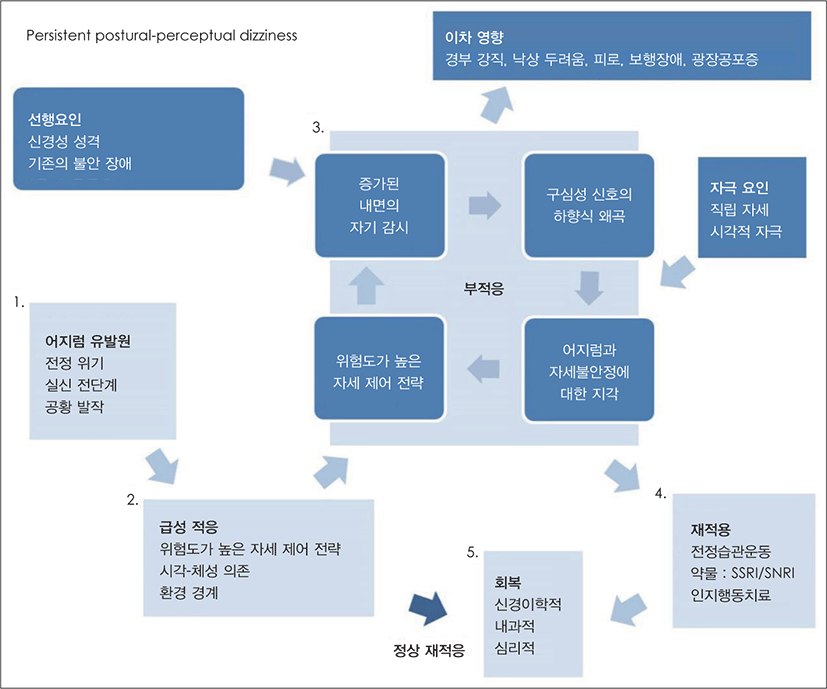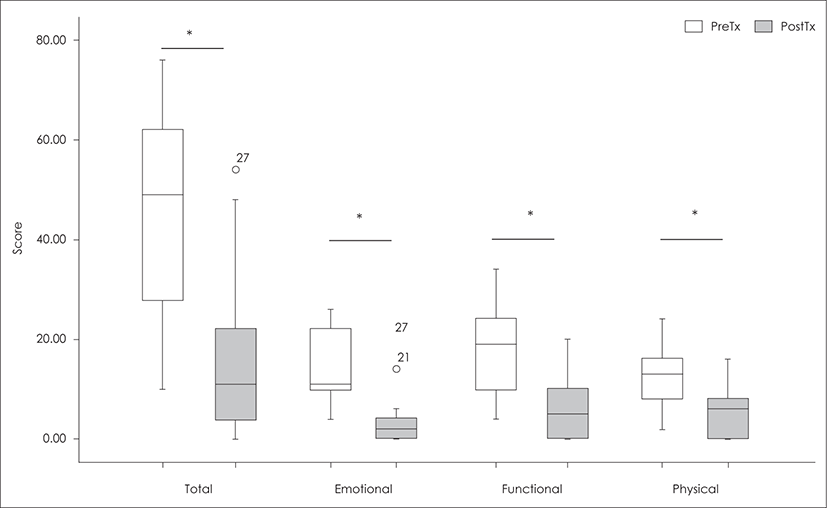서 론
지속적 체위-지각 어지럼(persistent postural-perceptual dizziness, PPPD)은 세계보건기구(World Health Organization, WHO)에 의해 2015년 국제질병분류(International Classification of Diseases, ICD-11)로 포함 되었는데, 기존의 만성 어지럼에 대한 다양한 진단명을 통합한 개념이라고 볼 수 있다.
만성 어지럼의 개념은 1980년대에 Brandt와 Dieterich1) 에 의해 처음으로 공포성 체위 현기증(phobic postural vertigo, PPV)이 제시되었고, 2000년대 초 Staab 등2)이 PPV 개념을 재정의하고 보완하여 만성 주관적 어지럼 (chronoc subjective dizziness, CSD)이라는 질병명을 추 가하였다. 그리고 공간 운동 장애(space motion discomfort, SMD), 시각성 현훈(visual vertigo), 심인성 보행 장 애(psychogenic gait disorder) 등과 같이 이전에 제안된 비슷한 질환들에 대해서 구조화되고 표준화된 정의를 도출하기 위해 2010, 2014년 Barany society에서 상기 제 시된 개념들을 함께 체계화하여 단일화된 전정질환으로 서 PPPD가 제안된 후 2015년 ICD-11에 포함되었다.3,4)
PPPD는 신경계의 만성적 기능 장애로 비회전성 현훈 과 체위성 자세불안을 가장 중요한 특징으로 보이며, 환 자가 서 있는 자세를 취하거나 복잡하거나 움직이는 시 각 자극이 있는 상황에서 악화된다.5,6) PPPD는 최근에 확립된 개념이어서 진단 및 치료에 대해서 알려져 있는 것이 많지 않으므로, 본문에서는 PPPD의 진단기준과 병 태생리, 치료방법 등을 알아보고 부산대병원에서 경험한 환자들의 치료 결과에 대해 보고하고자 한다.
본 론
WHO의 국제질병분류(ICD-11)에 포함된 PPPD의 진단은 모든 Bárány Society 진단 기준을 충족하여야 한 다(Table 1). 요약하면 수개월에서 수년 지속되는 만성질 환으로 아래의 6가지 특징을 가지는데,7) 1) 이학적인 검 사로는 발견할 수 없는 지속적인 흔들림 또는 불안정, 2) 기립 시에 증상의 악화, 3) 두부움직임이나 복잡한 시 각자극에 의해 증상의 악화, 4) 증상시작시 질병 또는 심 리적 충격의 존재, 5) 증상을 유발하는 동시질병의 존재, 6) 불안.
PPPD의 진단에서 환자의 병력 청취가 중요한데, 환 자들은 비회전성 현훈(“나는 눈 앞이 돌지는 않지만 움 직이는 느낌이 난다”,“나는 내 몸이 보트에 타고 있는 것 처럼 움직이는 것을 느낀다”)과 자세 불안정(“나는 내가 지금 막 넘어지려는 느낌이 든다”) 같은 체위성 자세불안 을 많이 호소하고, 시각 유발 어지럼, 예를 들면, 복잡하 거나 움직이는 시각 자극이 있는 환경(예 : 복잡한 무늬 의 카펫이 있는 복도, 사람이 많은 건널목)에서 악화되는 특징을 가진다.8)
PPPD에서 어지럼은 대개 호전과 악화를 보이지만 환 자들은 지속적이라고 표현하는 경향이 있으며, 진료실에 서 보는 안정적인 환자의 모습이나 검사실에서 시행하 는 전정검사의 정상적인 결과는 환자가 설명하는 일상 생활에서의 환자 증상의 강도 및 지속성 등과 대개 일치 하지 않는다. 그렇지만 대부분의 기능적 신경계 질환처럼 임상적 불일치는 증상의 왜곡이나 꾀병이 아닐 수 있으 며 PPPD에 대한 진단적 접근을 하는 것이 중요하다.
PPPD는 환자의 충분한 병력을 토대로 진단 기준에 맞춰 진단이 이루어지는 질병으로 다른 질병을 배제한 후 진단을 내리는 질환은 아니다. 따라서 신체 검사, 전정 기능 평가들은 다른 질환들을 배제하기 보다는 PPPD의 감별 질환의 동시 존재 유무를 평가하기 위해 필요하다. PPPD는 전정신경염, 양성 발작성 체위성 현훈, 메니에 르병 같은 급성, 발작성의 전정질환에 의해 유발될 뿐만 아니라, 공황장애, 불안장애 등 평형에 영향을 줄 수 있 는 다른 질환들 후에 유발될 수 있다.9)
PPPD의 병태생리학은 아직 정확히 밝혀지지 않았지 만, PPV, CSD 그리고 PPPD에 대한 생리학적 연구 및 구조적 기능적 신경 연구에서의 자료를 토대로 이 장애 가 발생하는 것으로 여겨지는 3가지 주요한 메커니즘이 밝혀졌는데, 첫째, 어지럼을 유발하는 인자가 있을 때 자 세 제어를 강화하는 것, 둘째, 공간 정보를 처리함에 있 어 전정을 통한 정보보다는 시각을 통한 정보에 의존하 는 것, 마지막으로 이러한 두 메커니즘을 조절하는 더 상 위 단계의 피질 메커니즘의 실패이다.3,10,11) 건강한 사람 에서도 어지럼 또는 현훈이 발생하거나 낙상의 위험이 있을 때 반응하는 체위조절체계(postural control system)(예 : 뻣뻣한 자세나 짧은 보폭)를 활성화하고 전정 신호보다는 시각 신호에 좀 더 의존하는 정상적인 생리 반응을 보이지만, 이러한 전략은 일반적으로 유발인자가 소실되면 안정화된다.12,13) 급성 유발인자의 소실 이후에 도 지속적인 어지럼이 발생하는 환자에서 이러한 증상 회복 실패의 원인은 높은 불안, 전정 및 균형 감각에 대 한 과도한 경계, 공간 방향에 대한 시각적 단서에 대한 지 속적인 높은 의존성 때문인 것으로 여겨진다.14-16) 기존 의 불안장애나 신경증 환자의 경우 이러한 비정상적 반 응이 잘 유발되는 경향이 있고, 이들은 체위조절체계의 재적응/습관화가 실패하며 과도한 자기 감시를 하게 되 고 이는 뇌에서 신체 움직임에 관한 체성 감각 정보를 확 대 해석하고 왜곡하여 결과적으로 환자가 주관적인 어 지럼과 자세 불안정을 느끼게 한다.17,18) 이러한 환자의 주 관적 어지럼과 자세 불안정은 다시 위험도가 높은 자세 전략을 취하게 하여 부적응의 악순환이 일어나게 한다 (Fig. 1). 위험도가 높은 자세 제어 전략은 PPV나 CSD 를 가진 환자에게서 주로 보이고 지속적인 시각 의존은 만성 어지럼이나 시각성 현훈을 가진 환자에서 주로 관 찰된다.19-21) 부적응의 만성화로 인해 일상적인 전정 및 시각 자극에 의해 주관적 어지럼이 발생하여 환자는 자 세 및 걸음걸이를 규제하거나,22) 비정상적인 자가 모니터 링의 증가된 부담에 의해 정신 과부하의 결과로서 해리 및 피로가 발생하거나,23) 비정상적인 자세 조절에 의해 목 경직 및 기능적 보행 장애 등의 이차 증상이 생길 수 있다.24) 이러한 상황에 의한 두려움과 회피는 광장 공포 증과 같은 이차 공포증을 일으킬 수 있다.25)

일반적으로 만성 어지럼 환자들은 대개 현훈이나 자 세 불안정을 야기하는 질환들을 앓은 병력을 가지고 있 는데 25%의 환자에서 말초성 전정 질환인 양성 발작성 두위현훈(benign paroxysmal positional vertigo)이나 전 정 신경염(vestibular neuritis) 등을 앓았었고, 20%에서 는 편두통성 어지럼(vestibular migraine)의 병력이 있었 으며 15%에서는 공황 발작이나 불안 장애를 가지고 있 었다.2)
PPPD에서 현재까지 대규모로 유병률 또는 발생률을 조사한 역학 연구는 없었고 환자-대조군 연구를 통해 PPPD의 특징에 대해 조사한 연구가 있었다. Bitta와 Lins7)는 81명의 PPPD 환자들을 대상으로 남녀차이는 없으며 평균 연령이 50세 정도이며, 가장 흔한 동반 질환 으로 고콜레스테롤혈증, 다음으로 편두통과 탄수화물 대사 장애순이라고 보고하였다. 그리고 삶의 질이 낮고 불안과 우울증을 더 많이 가지는 경향을 보였다.7) Yan 등26)은 43명의 PPPD환자와 45명의 대조군을 비교했는 데 대조군은 이전 3개월 이내에 항우울제없이 급성 현기 증으로부터 완전히 회복된 368명의 환자 그룹으로부터 무작위로 모집하였다. 그들은 전형적인 PPPD 환자의 나 이가 40세에서 60세 사이이고 성별에서는 여성 우세를 확인했고, 교육, 직업, 결혼 여부, 거주지, 가족 소득, 흡 연 이력, 알코올 소비, 고혈압, 편두통, 고지혈증, 당뇨병 및 허혈성 심장 질환과 같은 인구 통계학적 및 사회학적 요인에서 유의미한 차이는 없다고 보고하였다. 다만 PPPD 환자들은 대조군보다 수면위생(sleep hygiene)이 좋지 않 고, 불안 및 신경증 성격을 가지는 경향이 있다고 하였다.26)
위에서 PPPD 환자의 나이는 40~60세 사이이고 성별 에서는 여성 우세라는 것을 알 수 있다. 불안과 신경증 같은 정신적인면 이외 PPPD와 관련된 다른 동반 질환 의 증거는 없어 보인다.
PPPD의 치료는 크게 환자교육, 인지행동치료(cognitive-behavioural therapy, CBT), 약물치료 및 전정과 평 형 재활치료(vestibular and balance rehabilitation therapy, VBRT)가 알려져 있는데, 이것은 기존의 만성어지 럼의 치료와 유사하다.27) 만성어지럼에서 평균 32개월의 치료 후 78%에서 호전되었는데 이것은 PPPD에서도 비 슷한 결과가 예상된다.27) 치료는 우선 환자교육부터 시 작하는데 환자에게 진단명을 알려주고 이 병은 치료가 가능한 만성 어지럼이라고 설명한다.28) 이는 환자 자신이 이 질병을 예전에 치료한 적이 있고 잘 이해하고 있는 의 사를 만났다는 자신감을 불어넣어주게 된다. 그 후 Fig. 1 을 이용하여 환자에게 병의 유발인자, 발생 원리, 이차 증 상 및 치료에 대해 구체적으로 설명한다. 이러한 상담을 통해 의사는 환자의 문제점을 파악하고 전정과 평형 기 능을 둔화시키는 물리 치료 혹은 뇌에서 전정정보, 시각 정보 그리고 위협의 상호작용을 변화시키는 약물 치료 및 어지럼에 대한 과도한 경계를 낮추고 어지럼의 결과 에 대한 걱정을 줄여주는 인지 행동 치료 중에 환자에게 필요한 치료를 선택할 수 있다.28-30)
좋은 수면위생, 육체적 운동 및 균형잡힌 식사 같은 건 강한 생활습관은 불안을 완화하고 정신건강을 향상시키 는 것을 도와주며 환자가 PPPD의 부적응 상태에서 벗어 나도록 할 수 있다.31) 기능적 어지럼이 존재할 경우 VBRT 이 가장 추천된다.32,33) 이 운동의 목적은 움직임에 대한 잘못된 반사 반응을 줄이고 시각적 자극에 대한 민감도 를 줄이는 것이다.9) PPPD 환자에서 시행하는 VBRT는 구조적 전정 장애가 있는 환자에서 시행되는 VBRT보다 부드럽게 시작하고 천천히 운동 강도를 증가시켜야 하는 데 공격적인 치료는 오히려 증상을 악화시키고 순응도 를 떨어뜨릴 수 있기 때문이다.34)
약물치료는 선택적 세로토닌 재흡수 억제제(selective serotonin reuptake inhibitors, SSRI)와 세로토닌 노르 에피네프린 재흡수 억제제(serotonin norepinephrine reuptake inhibitors, SNRI)가 권유되고 있으며 불안회 로와 움직임에 반응하는 중추성 전정신경세포를 통한 신 경전도를 변화시키고 조절한다. SSRI와 SNRI는 만성 주관적 어지럼을 가진 대부분의 환자에서 어지럼과 자 세 불안정을 줄이는 효과를 보였다.4) 이런 약물은 환자에 내재된 불안수준에서 비적응 순환(maladaptation cycle) 을 깨뜨림으로서 정상으로 환자를 재적응(re-adaptation)하는 역할을 한다. 약물의 초기용량은 천천히 증량 하고 우울증에 사용하는 약물의 절반 정도의 용량에서 도 반응을 잘한다.31) PPPD는 다른 신경증 환자들처럼 약 물치료의 부작용에 더 예민한 경향이 있으므로 빠른 증 량은 조기에 순응이 떨어질 수 있다. 우선 SSRI로 시작 하고 초기 반응이 떨어진다면 다른 SSRI로 바꾸고 최종 적으로 SNRI를 사용할 수 있지만 SNRI는 SSRI에 비해 부작용이 많음을 치료자는 인지하고 있어야 한다. 대개 치료 반응은 8~12주 후에 나타나기 시작하는데 효과가 있다면 적어도 1년은 사용하는 것이 좋다.31)
CBT는 이전의 CSD, PPV 등에서 효과를 나타내었 다.35-38) 특히 치료를 빨리 시작할수록 치료 효과가 오래 지속되며 수년간의 고착화된 증상은 환자에게 높은 부 적응율, 더 심각한 이차 증상, 본인의 질병에 대한 포기 를 야기한다고 한다.11) CBT는 단독보다는 약물 및 전정 재활치료를 포함하는 종합적인 접근의 일부로 사용될 때 추가적인 긍정적인 효과를 보이는 것으로 보였다.36) 최근에 PPPD에서의 CBT 역할에 대해서 Yu 등39)은 CBT 가 SSRI로 치료받는 환자에서 증강 효과를 갖는 것으로 밝혔는데, 병용 요법을 받는 환자는 현기증, 불안 및 우울 증 지수가 개선되었으며, 더 적은 양의 SSRI로도 증상을 조절할 수 있었다.
부산대학교병원의 경험
2018년 1월부터 2019년 3월까지 어지럼을 주소로 내 원한 환자 182명 중 PPPD로 진단된 환자 중 6개월 이상 경과관찰을 할 수 있었던 14명을 대상으로 하였다. 내원 당시 PPPD로 진단된 환자는 23명으로 전체 환자의 12.6% 였으며, 이 중 연구대상에 포함된 환자의 평균나이는 56.6±13.6세였고 남자 3명, 여자 11명으로 기존의 연구 결과와 유사하였다. 평균 7.6±2.4개월의 경과관찰 기간 동안 3~6회 외래를 방문하였고 모두 CBT, VBRT, SSRI 인 Escitalopram(Lexapro®) 5 mg으로 치료하였다. 3개 월 후 약물치료의 효과가 만족스럽지 못할 경우 10 mg 으로 증량하였다. 내원당시와 마지막 내원시의 어지럼 정도를 대표적 어지럼 설문지인 한국어판 어지럼장애 척도(Korean Dizziness Handicap Inventory, KDHI)를 통해 비교하였는데 KDHI의 세부 영역인 정서적 영역 (emotional scale), 기능적 영역(functional scale), 신체적 영역(physical scale)을 포함하였다. 내원당시 KDHI는 총점 44.4점, 정서적 영역 14.4점, 기능적 영역 17.7점, 신 체적 영역 12.2점 이었다. 마지막 경과관찰시에는 총점 16.1점, 정서적 영역 3.8점, 기능적 영역 6.4점, 신체적 영 역 5.7점이었다. Wilcoxon signed rank test를 이용한 결 과 총점과 세가지 세부 항목에서 모두 통계학적으로 의 미있게 감소하였음을 보였다(Fig. 2).

